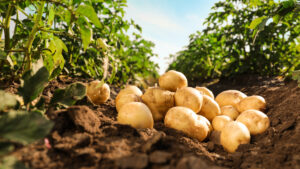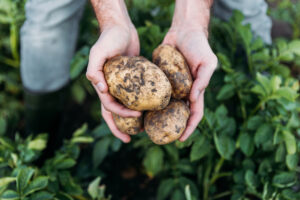 Potatoes are recognized as the fourth most cultivated crop worldwide and hold a significant place in various cuisines due to their adaptability, nutritional value, and versatility. This prominence and their consistent demand make them a top choice for many farmers.
Potatoes are recognized as the fourth most cultivated crop worldwide and hold a significant place in various cuisines due to their adaptability, nutritional value, and versatility. This prominence and their consistent demand make them a top choice for many farmers.
Small-scale potato farming presents numerous advantages. It not only ensures a more attentive and sustainable approach to cultivation but also leads to superior yield quality. Additionally, it grants farmers the unique opportunity to tap into niche markets, particularly those seeking organic or specialty potato varieties.
This guide offers a comprehensive overview, spanning from soil preparation to effective market strategies, ensuring your small-scale potato farming venture flourishes.
Getting Started
Starting a small-scale potato farm demands meticulous planning and a keen understanding of agricultural nuances. As you venture into this rewarding feat, here are essential factors to contemplate:
- Land
 Selecting the right plot for potato farming is akin to laying the foundation for a building. The land’s quality can profoundly impact the resultant yield. It’s advisable to opt for a plot with loamy, well-draining soil, which ensures optimal growth conditions for the potato tubers.
Selecting the right plot for potato farming is akin to laying the foundation for a building. The land’s quality can profoundly impact the resultant yield. It’s advisable to opt for a plot with loamy, well-draining soil, which ensures optimal growth conditions for the potato tubers.
The land’s location also plays a pivotal role. Proximity to your residence can facilitate easy supervision and management, while closeness to water resources ensures timely irrigation. Furthermore, a location near potential marketplaces can reduce transportation costs and ensure that the produce reaches consumers while still fresh.
- Potato Seed Varieties
The diversity in potato seed varieties offers farmers a spectrum of choices, each with its unique attributes. The decision on the variety to plant should be influenced by multiple factors, including the local climate, soil type, and market demand.
Researching and understanding the preferences of your target market can guide this decision. Moreover, it’s of utmost importance to source certified disease-free seeds, ensuring a healthy start to the cultivation process and significantly reducing the risk of crop infections.
- Tools And Equipment
A farmer’s efficiency is often tied to the quality and appropriateness of the equipment at their disposal. While basic tools like hoes and spades are essential, larger plots may necessitate the use of mechanized equipment such as tillers or planters. For reliable and high-quality options, consider exploring offerings from Milestone Equipment and other trusted retailers.
These not only save time but also enhance precision. Additionally, in regions prone to unpredictable rainfall patterns, integrating a robust irrigation system becomes crucial to maintain consistent crop hydration.
- Irrigation System
Water is a lifeline for crops, and its consistent and appropriate supply is vital for optimal potato growth. Tailoring an irrigation strategy based on the specific needs of the region and soil type can make a significant difference in crop yield.
Techniques like drip irrigation can provide targeted hydration, while sprinkler systems offer more widespread coverage. Furrow irrigation, on the other hand, is especially beneficial in certain terrains. Evaluating the pros and cons of each system in the context of your farm can guide the best choice.
- Storage Facilities
Once harvested, the journey of the potato is far from over. Proper storage can mean the difference between a long shelf life and rapid spoilage. Potatoes require specific conditions for storage, primarily cool, dark, and well-ventilated spaces. These conditions slow down the sprouting process, retaining the potato’s freshness for longer.
Whether you opt for traditional root cellars or invest in modern, specialized storage facilities, ensuring these conditions are met will protect your hard-earned harvest and optimize its market longevity.
Embarking on a potato farming journey, albeit on a petite scale, is an intricate blend of passion, commitment, and expertise. With thorough groundwork, unwavering dedication, and perpetual learning, flourishing harvests, and business success are well within reach.
Preparing The Soil And Field
The foundation of a prosperous potato harvest lies beneath the surface. Proper soil and field preparation are paramount in cultivating a bountiful crop, ensuring that the potatoes have the most conducive environment for growth and development.
- Selecting The Right Soil Type
Soil composition plays an integral role in determining the health and yield of potato crops. Loamy soils, rich in organic matter and with good water retention properties, are highly favored for potatoes. These soils offer the dual benefit of retaining moisture without waterlogging the roots.
An optimal pH level is another critical factor. Keeping the pH between 5.2 and 6.4 not only supports potato growth but actively deters many soil-borne diseases. Alkaline or overly acidic soils can hinder nutrient absorption and increase susceptibility to pests and diseases.
- Soil Testing And Nutrient Management
Just as a doctor would require a blood test to understand a patient’s health, a farmer needs a soil test to comprehend the soil’s health. A comprehensive soil test paints a detailed picture of its nutrient levels, mineral content, and potential pH imbalances.
With this data at hand, farmers can make informed decisions about the type and amount of fertilizers and soil amendments required, ensuring the potatoes receive a balanced diet throughout their growth.
- Field Preparation Techniques
Physical preparation of the field acts as a precursor to successful potato cultivation. Tilling, for instance, is essential as it breaks up compacted soil, enhancing soil aeration and making it easier for roots to penetrate deeply.
This deep tilling, reaching 8-12 inches, paves the way for robust root systems and larger tubers. Beyond tilling, a vigilant removal of weeds, stones, and other debris is necessary. These intruders can obstruct tuber growth and provide refuge for pests.
- Implementing Crop Rotation
Nature thrives on diversity, and so do farmlands. Repeatedly planting potatoes in the same field exhausts specific soil nutrients and creates a haven for potato-specific pests and diseases.
Introducing a crop rotation system with crops such as beans or corn rejuvenates the soil and interrupts the life cycles of these pests and diseases. This holistic approach ensures the soil remains fertile and the crops healthy in the long run.
Planting And Cultivating Potatoes
From field preparation, the journey moves into the heart of potato farming—the planting and nurturing stage. Each step here, from seed selection to pest control, plays a pivotal role in determining the final yield and quality of the crop.
- Choosing The Right Potato Varieties
The multitude of potato varieties available offers farmers a choice tailored to their specific needs. From the starchy russets ideal for baking to the waxy reds suited for salads, the variety chosen must align with the intended market and end-use.
Additionally, considering the local climate and disease resistance of specific varieties can further enhance harvest success.
- Seed Preparation And Cutting
The journey of a healthy potato crop begins with the seed. Utilizing certified disease-free seeds can significantly lower the risk of introducing infections into the field.
For those adopting seed cutting as a propagation method, it’s crucial that each cut segment contains 1 to 2 eyes, which are the growth points from which the plant emerges. Furthermore, allowing these cut pieces to cure for a couple of days before planting helps reduce the risk of rot once they’re in the ground.
- Planting Techniques And Spacing
The way potatoes are planted can significantly influence their growth. If planted too shallow, the emerging tubers risk exposure to sunlight, turning them green and potentially toxic. A depth of 3-5 inches is ideal.
Proper spacing, around 12 inches between seeds, ensures that each plant has enough space to grow without competing for nutrients. Similarly, rows spaced 30-36 inches apart optimize airflow, reducing the risks of fungal diseases and easing cultivation.
- Watering And Fertilization Needs
Water is life, especially for the potato plant during its tuber formation stage. Consistency in moisture levels can prevent issues like scabbing or irregularly shaped potatoes. Fertilization, informed by prior soil tests, ensures a steady supply of essential nutrients.
Over-fertilization, particularly with nitrogen-heavy fertilizers, might promote lush foliage at the expense of tuber development.
- Weed And Pest Management
The threats to a potato crop are many, with weeds and pests being the primary culprits. Regular field inspections can nip potential infestations in the bud.
Adopting organic methods, such as introducing beneficial insects or using neem oil, can keep pests at bay without resorting to chemical interventions. Similarly, strategies like mulching can suppress weed growth, ensuring that the potatoes have an unimpeded growth environment.
Harvesting And Storage
The final chapter of the potato’s journey in the field culminates in the harvest and its subsequent storage. Proper techniques in these phases can substantially influence the quality, longevity, and profitability of your produce.
- Identifying The Right Time To Harvest
Understanding the growth stage of your potatoes is paramount in determining the harvest time. While early harvesting can yield tender new potatoes, ideal for immediate consumption, waiting for the plants to naturally senesce and the foliage to die back signals that the potatoes have reached full maturity. Such matured tubers have developed thicker skins that better equip them for longer storage durations.
- Harvesting Techniques And Tools
The delicate nature of potatoes necessitates a gentle touch during harvesting. Rushing this process or using inappropriate tools can lead to bruises or cuts on the tubers.
A garden fork, adeptly maneuvered, offers precision and gentleness, allowing farmers to lift the soil and retrieve the potatoes with minimal damage. Damaged potatoes not only deteriorate faster but are also more susceptible to diseases during storage.
- Post-Harvest Handling
Like a fine wine, potatoes benefit from a bit of aging. Immediately after harvesting, allowing them to dry on the field for several hours can shed excess moisture.
This brief exposure is followed by a curing process, where the potatoes are kept in a cool, dark environment for about two weeks. This curing not only toughens the skin, making them less prone to injuries, but also helps heal any minor cuts or abrasions.
- Storage Options And Best Practices
The longevity of potatoes in storage is a direct result of the conditions they’re kept in. An environment mirroring a cave—cool, moderately humid, and devoid of light—ensures that the potatoes remain dormant and fresh.
Additionally, using storage mediums like crates or mesh bags can enhance air circulation, minimizing moisture build-up and reducing rot’s risk. Remember, potatoes are living organisms; they respire, and without proper air circulation, they can suffocate and degrade.
- Managing Diseases And Pests In Storage
A storage facility is not an impregnable fortress. Pests and diseases can infiltrate, and their presence, if unchecked, can jeopardize the entire stored crop. Implementing a rigorous inspection routine helps in early detection and intervention. Any potatoes showing signs of decay, mold, or pest infestation should be immediately culled to protect the surrounding tubers.
Marketing And Selling Your Produce
Successfully cultivating a potato crop is merely the prelude. Transforming that produce into revenue demands astute marketing and sales strategies that resonate with the target market.
- Understanding The Potato Market
The dynamic nature of the agricultural market requires farmers to be perpetually informed. Recognizing shifts in consumer preferences, whether they lean towards organic produce, specific heirloom varieties, or low-carb alternatives, can significantly influence farming decisions and marketing angles.
- Packaging And Presentation Tips
Buyers are instinctively drawn to attractively packaged goods. Investing in aesthetic, sustainable packaging not only captures attention but also positions the produce as environmentally responsible, which is a significant draw for eco-conscious consumers.
- Exploring Different Sales Channels
Diversification is a hallmark of resilience. While local markets and grocery stores are mainstays, expanding to alternative channels like farmers’ markets, online sales platforms, or even establishing supply chains with local restaurants and cafés can diversify income streams and mitigate risks.
- Building Relationships With Buyers
The agricultural sector, at its core, thrives on relationships. Nurturing trust and reliability with buyers and distributors can pave the way for repeat business. Offering occasional samples, consistently delivering quality produce, and being receptive to feedback fosters a bond that transcends mere transactional interactions.
- Pricing Strategies For Maximum Profit
Pricing is an intricate dance between cost, value, and perception. While covering operational costs is non-negotiable, understanding the market’s pulse, gauging competitor pricing, and discerning consumers’ perceived value can inform pricing strategies. Additionally, incentives like volume discounts, loyalty programs, or early-bird offers can drive sales and enhance customer loyalty.
The Bottom Line
In the vast panorama of agriculture, potatoes stand out as a beacon of adaptability, nutrition, and universal appeal. Their widespread cultivation and enduring demand underline their significance.
Small-scale potato farming offers a strategic entry point into this arena, merging sustainability with profitability. By meticulously attending to each phase, from soil preparation to effective market strategies, farmers can unlock the full potential of their crop.
As with any endeavor, success in potato farming is a harmonious blend of knowledge, diligence, and innovation. Whether you’re an aspiring agriculturist or a seasoned farmer, this guide serves as a compass, steering you toward bountiful harvests and thriving market ventures.


